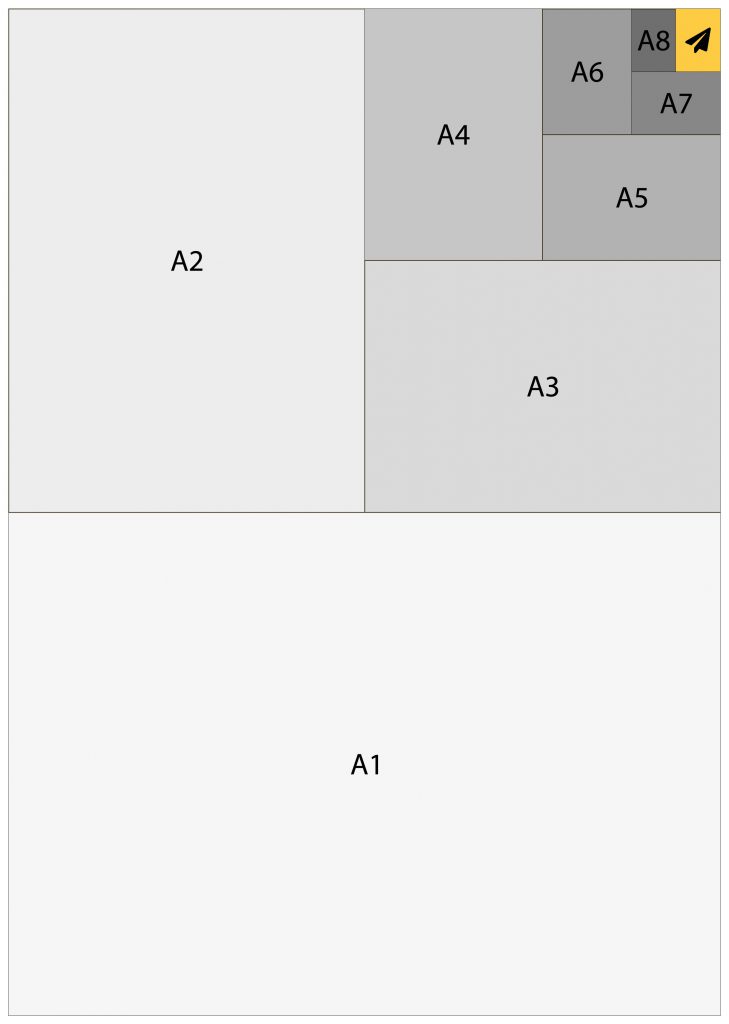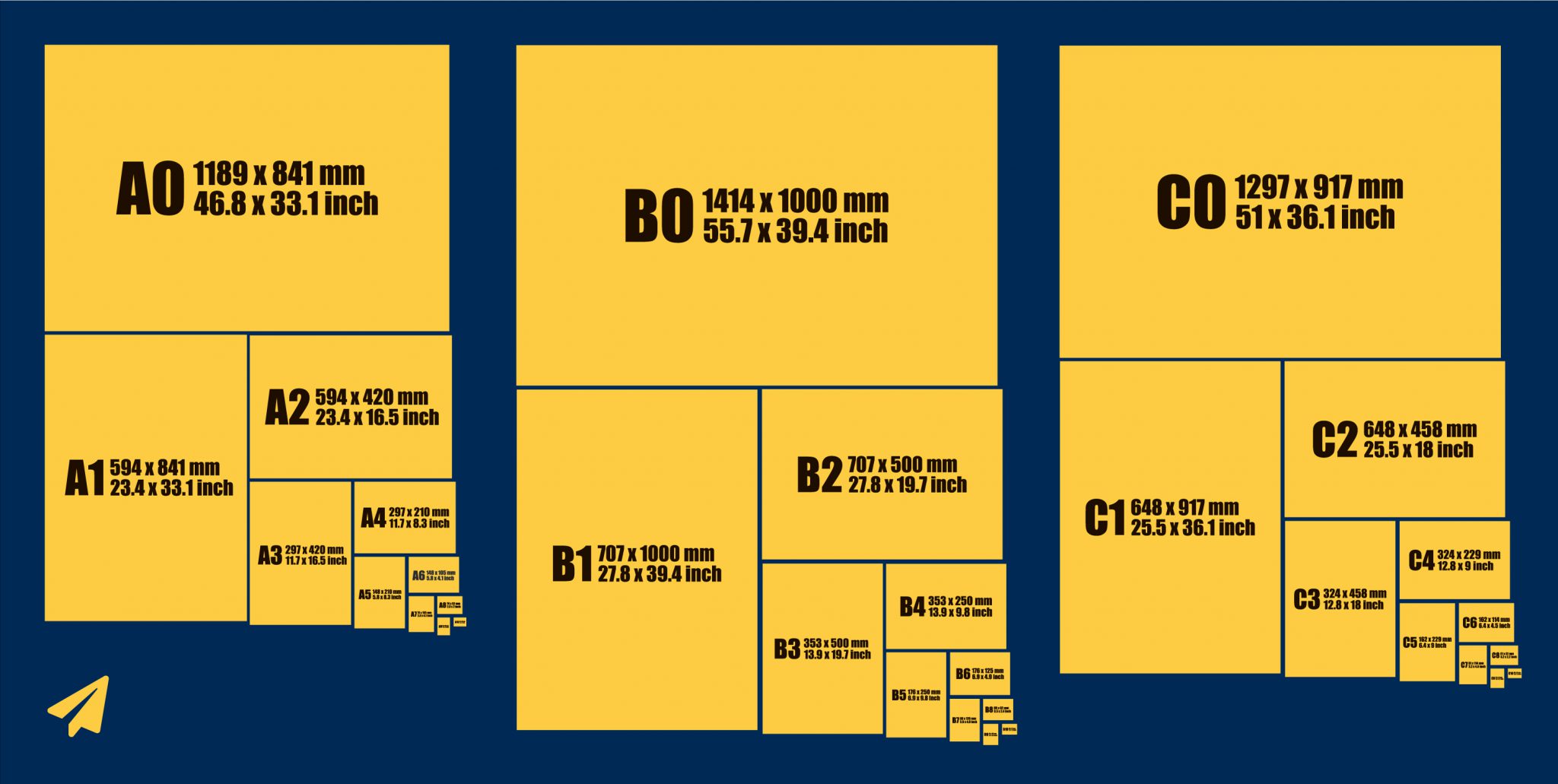The international paper standard is the ISO 216 standard. The ISO 216 standard is based on the German DIN 476 standard for paper sizes. More background information and history about the ISO 216 standard can be found here. The international paper sizes are divided into A, B and C series. All sizes within the ISO standard are based on a length/width ratio. The slanted side is √2 or 21⁄2.
The A-standard
With the A-Standard of paper, each successive size in the series has twice as large or small an area. The ratio is 2:1. If you cut a sheet of paper in the width into two equal pieces, two sheets of paper with the same ratio will be created.
The ratio between the long side and the short side is the square root from 2 (√2). This is about 1.414. This ratio is also called the Lichtenberg ratio.
With the A-Standard of paper, each successive size in the series has twice as large or small an area. The ratio is 2:1. If you cut a sheet of paper width into two equal pieces, two sheets of paper with the same ratio will be created. The area of a sheet of A0 paper is exactly 1 square meter (m²). The A0 size is the first of the A-series paper sizes. Because an A1 is half the size of an A0, and A1 has a surface area of a quarter of a square meter (m²). An A2 has half the surface area of an A1, and so on. It follows that an A2 has a surface area of ½ × ½ = 1/4 m².
The surface area is equal to the length x width. From this it follows: O = L x B. Also the length-width ratio can be displayed with L / B = √2. This formula can also be written as L = B x √2.

ISO 216 A Series
The table below shows the ISO 216 A series per size in inches and millimeters.
| Size | mm x mm | inch x inch |
|---|---|---|
| A0 | 841 × 1,189 | 33 1⁄8 × 46 19⁄24 |
| A1 | 594 × 841 | 23 3⁄8 × 33 1⁄8 |
| A2 | 42r0 × 594 | 23 3⁄8 × 33 1⁄8 |
| A3 | 297 × 420 | 11 17⁄24 × 16 13⁄24 |
| A4 | 210 × 297 | 8 1⁄4 × 11 17⁄24 |
| A5 | 148 × 210 | 5 5⁄6 × 8 1⁄4 |
| A6 | 105 × 148 | 4 1⁄8 × 5 5⁄6 |
| A7 | 74 × 105 | 2 11⁄12 × 4 1⁄8 |
| A8 | 52 × 74 | 2 1⁄24 × 2 11⁄12 |
| A9 | 37 × 52 | 1 11⁄24 × 2 1⁄24 |
| A10 | 26 × 37 | 1 1⁄24 × 1 11⁄24 |
The B standard
The ISO 216 B series are the same as the A-Series, with the same ratio. The difference between the A-Series and the B-Series is that the surface area differs per size.
In practice, the B-series is used much less often than the A-series. An example of the use of the B-series is posters. A poster has a surface area of a B2 size. This is 50 x 70 centimetres. Books often have a B5 size and passports a B7 size. B4, B5 and B6 are often applied to envelopes used for the C-series.
ISO 216 B-series
The table below shows the ISO 216 B series per size in inches and millimeters.
| Size | mm x mm | inch x inch |
|---|---|---|
| B0 | 1,000 × 1,414 | 39 3⁄8 × 55 2⁄3 |
| B1 | 707 × 1,000 | 27 5⁄6 × 39 3⁄8 |
| B2 | 500 × 707 | 19 2⁄3 × 27 5⁄6 |
| B3 | 353 × 500 | 13 11⁄12 × 19 2⁄3 |
| B4 | 250 × 353 | 9 5⁄6 × 13 11⁄12 |
| B5 | 176 × 250 | 6 11⁄12 × 9 5⁄6 |
| B6 | 125 × 176 | 4 11⁄12 × 6 11⁄12 |
| B7 | 88 × 125 | 3 11⁄24 × 4 11⁄12 |
| B8 | 62 × 88 | 2 11⁄24 × 3 11⁄24 |
| B9 | 44 × 62 | 1 3⁄4 × 2 11⁄24 |
| B10 | 31 × 44 | 1 5⁄24 × 1 3⁄4 |
The C standard
The C series is defined in the ISO 269 standard. The C series is mainly used for envelopes. The area of the C series is the geometric mean of the A and B series with the same number.
ISO 216 C-series
The table below shows the ISO 216 C series per size in inches and millimeters.
| Size | mm x mm | inch x inch |
|---|---|---|
| C0 | 917 × 1,297 | 36 1⁄12 × 51 1⁄12 |
| C1 | 648 × 917 | 25 1⁄2 × 36 1⁄12 |
| C2 | 458 × 648 | 18 1⁄24 × 25 1⁄2 |
| C3 | 324 × 458 | 12 3⁄4 × 18 1⁄24 |
| C4 | 229 × 324 | 9 × 12 3⁄4 |
| C5 | 162 × 229 | 6 3⁄8 × 9 |
| C6 | 114 × 162 | 4 1⁄2 × 6 3⁄8 |
| C7 | 81 × 114 | 3 5⁄24 × 4 1⁄2 |
| C8 | 57 × 81 | 2 1⁄4 × 3 5⁄24 |
| C9 | 40 × 57 | 1 7⁄12 × 2 1⁄4 |
| C10 | 28 × 40 | 1 1⁄12 × 1 7⁄12 |
Overview of the international paper sizes

